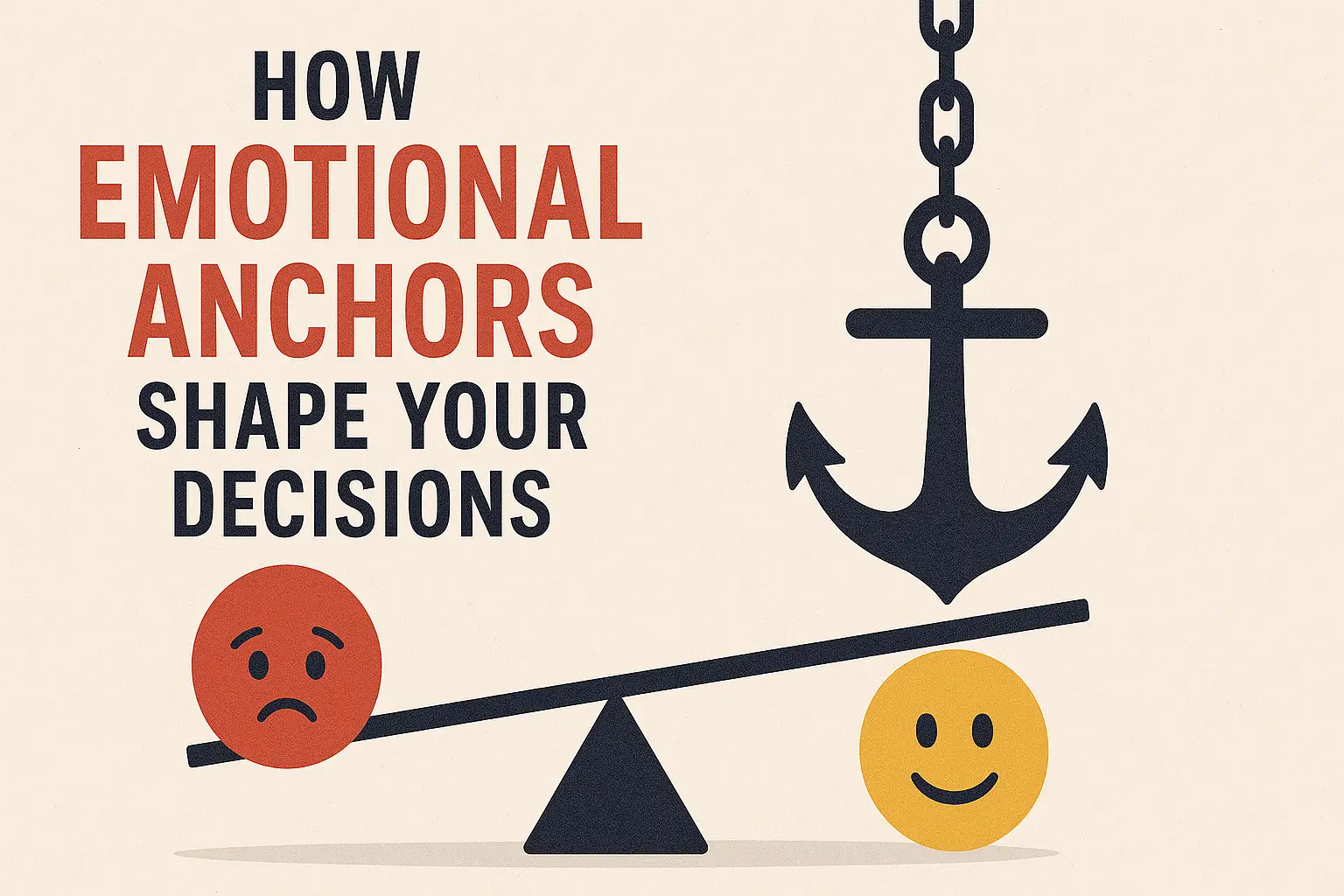“The mind is everything; what you think, you become.” – Buddha
This profound quote highlights the immense power of our thoughts and emotions in shaping our lives. Our brains are wired to create connections between experiences and emotions, forming the foundation of our perceptions and behaviors. As an “automatic meaning-making machine,” our mind constantly interprets and responds to situations based on past experiences and long-held beliefs.
Understanding how these connections, or anchors, influence our decisions is crucial for personal growth and improvement. By recognizing and resetting these anchors, we can transform our lives and make more informed choices.
Key Takeaways
- Discover how your brain creates connections between experiences and emotions.
- Learn the importance of understanding emotional anchors for personal growth.
- Understand how to recognize and reset anchors that influence your decisions.
- Explore the transformative potential of consciously using emotional anchors.
- Gain insights into how past experiences shape your current reactions.
The Power of Emotional Anchoring in Our Daily Lives
Emotional anchors, formed through our experiences, play a crucial role in determining our responses to various situations. These anchors are created when we associate a particular emotion with a moment or experience, often subconsciously. As a result, our past can continue to influence our actions and emotional health long after the initial experience has passed.
What Makes Us Automatic Meaning-Making Machines
Humans are inherently meaning-making machines. We have a natural tendency to create connections between our experiences and the emotions associated with them. For example, a specificsongmight evoke a strong emotionalresponsebecause it was playing during a significant event in our past. This automatic process occurs even when we’re not consciously recalling the memory. As a result, our brains are constantly creatingemotional anchorsthat can be triggered by various stimuli, such as smells, tastes, or visual cues.
How Our Past Experiences Shape Current Reactions
Our pastexperiencescreate lasting emotional imprints that shape our current reactions. For instance, a person who had a traumatic experience inschoolmight feel anxious in similar environments later in life. These emotional anchors can be triggered by sensory stimuli, transporting us back to past emotional states. By understanding how our past shapes our current reactions, we can begin to identify patterns in our emotional responses and recognize when our reactions are based on past anchors rather than present reality.

Understanding Emotional Anchoring
Understanding emotional anchoring is crucial for grasping how our experiences shape our emotional responses over time. Emotional anchors are stimuli that trigger specific emotional states, and they can be incredibly powerful in influencing our feelings and behaviors. The good news is that it’s possible to have an anchor that helps us experience certain emotions automatically and instantaneously. However, for most people, these anchors are often external, created without awareness or choice, and developed over years of repetition.

The Science Behind Emotional Anchors
Emotional anchoring is rooted in the brain’s tendency to create associations between different stimuli and emotional responses. This process is deeply connected to the concept of classical conditioning, where neutral stimuli become linked to emotional experiences. Over time, these associations can become automatic, allowing our minds to process information more efficiently. As a result, emotional anchors can significantly impact our daily lives, influencing our emotions and decision-making processes.
Why We Form Emotional Associations
Humans naturally form emotional associations as a way to navigate their environment and make sense of their experiences. These associations serve as mental shortcuts, conserving cognitive resources and enabling us to respond quickly to familiar situations. By forming emotional anchors, our minds can categorize experiences efficiently and anticipate potential threats or opportunities. This process contributes to our sense of identity and personal narrative, shaping our perception of health, relationships, and overall well-being.
How Emotional Anchors Influence Your Decision-Making
Emotional anchors significantly influence our decision-making processes, often operating beneath our conscious awareness. These anchors can be formed through various experiences and interactions, shaping our perceptions and choices in profound ways.
As illustrated in the example where you’re introduced to a highly successful businessperson, emotional anchoring can occur instantaneously. You might immediately assign a high value to this person based solely on their reputation, without knowing them personally. This initial impression can significantly impact your subsequent interactions and decisions.
The Subconscious Impact on Choices
Emotional anchors can lead to subconscious biases that affect our decision-making. For instance, a past experience associated with strong emotions can create an anchor that influences future decisions, even if the current situation is quite different. As “The mind is everything; what you think, you become.” – Buddha. This highlights the powerful role of emotional anchoring in shaping our choices.
These anchors can operate in various aspects of life, from professional settings to personal relationships. Recognizing the subconscious impact of emotional anchors is crucial for making informed decisions that are not unduly influenced by past experiences.
When Anchors Lead You Astray
Sometimes, emotional anchors can lead us astray by creating unrealistic expectations or biases. For example, if a past experience has created a negative emotional anchor, it might cause you to misinterpret or overreact to similar situations in the present. This can result in missed opportunities or strained relationships.
Being aware of these potential pitfalls is essential. By understanding how emotional anchors work and recognizing when they are influencing your decisions, you can take steps to mitigate their negative impacts and make more balanced choices.

Types of Emotional Anchors
Emotional anchoring is a multifaceted phenomenon, manifesting through various sensory experiences. Our daily lives are influenced by different types of emotional anchors that shape our feelings, behaviors, and decisions. Understanding these anchors is crucial for managing our emotional responses and improving our well-being.
Visual Anchors: What We See
Visual anchors are perhaps the most obvious type of emotional anchor. They are triggered by what we see, such as a person’s face, a place, or an object. For instance, a favorite childhood photo can evoke feelings of happiness and nostalgia. On the other hand, a particular image or scene can also trigger negative emotions. Visual anchors have a significant impact on our emotional state, as they directly influence our perception and memory.
Auditory Anchors: What We Hear
Auditory anchors are another powerful type of emotional anchor. Sounds, music, or even voices can instantly transport us to a different emotional state. For example, a particular song might remind you of a memorable event or person, eliciting strong emotions. As “music is the divine way to tell beautiful, poetic things to the heart”, as Pablo Casals once said, highlighting the profound impact of auditory anchors on our emotional lives.
Kinesthetic Anchors: What We Feel, Smell, and Taste
Kinesthetic anchors are more subtle yet incredibly potent. They encompass sensations such as touch, temperature, smells, and tastes. For example, the smell of a certain perfume or the taste of a particular dish can evoke strong emotional responses. As noted, “the food your grandmother used to cook for you when you were a child will always evoke sentimental feelings and remind you of a happy childhood.” These anchors are often linked to memories and experiences from our past, making them particularly influential.
Kinesthetic anchors operate through our physical senses, creating some of our strongest emotional associations. Touch, physical sensations, smells, and tastes can instantly trigger powerful emotional states. For instance, a comforting hug or a familiar scent can provide a sense of security and comfort. Businesses often leverage kinesthetic anchors by using signature scents or textures to create emotional connections with their customers.
Identifying Your Personal Emotional Anchors
Recognizing personal emotional anchors is the first step towards gaining control over our emotional state. Emotional anchors are deeply ingrained and can be triggered by various stimuli, influencing our thoughts, feelings, and actions. To identify these anchors, one must develop awareness of their emotional responses and the triggers that cause them.
Mindfulness and Emotional Awareness
Mindfulness techniques can help create space between emotional triggers and reactions, allowing individuals to observe their emotional patterns without judgment. By practicing mindfulness, one can begin to loosen the grip of negative emotional anchors over time. This process involves recognizing whether an anchor is positive or negative and understanding its impact on one’s emotional state.
Awareness is key to breaking automatic negative thought patterns. When individuals are aware of their unhelpful thought patterns, they can shift back into a more positive state. This awareness is crucial in creating connections between thoughts, feelings, and situations, highlighting the importance of mindfulness in the process.
The Power of Awareness in Breaking Automatic Responses
Developing awareness is the crucial first step in breaking free from automatic emotional responses. By observing emotional patterns without judgment, individuals can begin to understand their triggers and responses. This understanding creates choice points where new responses can be substituted for automatic reactions, allowing for personal growth and transformation.
Through practices like mindfulness and self-reflection, individuals can track their emotional responses over time, revealing patterns and recurring triggers. This knowledge empowers them to manage their emotional anchors more effectively, leading to a more balanced and controlled emotional state.
The 4-Step Process to Reset Negative Emotional Anchors
By understanding and applying the 4-step process to reset negative emotional anchors, individuals can significantly improve their emotional well-being. This process is designed to help people break free from the grip of negative emotional patterns and cultivate a more positive outlook on life.
Awareness: Recognizing the Pattern
The first step in resetting negative emotional anchors is awareness. This involves recognizing the patterns and triggers that lead to negative emotional responses. By becoming more mindful of these patterns, individuals can begin to understand how their emotional anchors are formed and how they impact their daily lives.
Interruption: Breaking the Connection
Once aware of their negative emotional anchors, individuals can proceed to interrupt the anchoring process. This involves breaking the connection between the trigger and the negative emotional response. Techniques such as mindfulness and deep breathing can be effective in interrupting the anchoring process.
Reframing: Creating New Meanings
The third step is reframing, which involves creating new meanings and associations to replace the negative ones. By reframing their experiences, individuals can begin to see things from a different perspective and develop more positive emotional responses.
Practice: Reinforcing New Patterns
The final step is practice, which is crucial for reinforcing new emotional patterns. Consistent practice helps to strengthen new neural pathways, gradually replacing old emotional anchoring patterns. Repetition is key in this process, as it solidifies new emotional associations and makes them more automatic over time.
| Step | Description | Techniques |
|---|---|---|
| Awareness | Recognizing negative emotional patterns | Mindfulness, self-reflection |
| Interruption | Breaking the connection between trigger and response | Mindfulness, deep breathing |
| Reframing | Creating new meanings and associations | Cognitive restructuring, positive self-talk |
| Practice | Reinforcing new emotional patterns | Repetition, visualization |
Consistent practice is essential for making new emotional patterns become automatic and effortless. By scheduling regular practice sessions and tracking progress, individuals can maintain motivation and continue to reinforce positive emotional anchors.
Creating Powerful Positive Anchors
By understanding how to create positive anchors, you can take control of your emotional well-being and improve your overall quality of life. Emotional anchors are stimuli that trigger specific emotional responses, and when used effectively, they can become a potent tool for personal transformation.
The ITUR Method: A Framework for Effective Anchoring
The ITUR method provides a structured approach to creating powerful anchors. ITUR stands for Intensity, Timing, Uniqueness, and Repetition. Intensity refers to the strength of the emotional state you are trying to anchor. The more intense the emotion, the stronger the anchor is likely to be. Timing is critical; the anchor should be applied at the peak of the emotional experience. Uniqueness ensures that the anchor is distinct and not easily triggered accidentally. Finally, Repetition reinforces the anchor, making it more reliable over time.
To illustrate the ITUR method, consider the following table:
| ITUR Component | Description | Example |
|---|---|---|
| Intensity | The strength of the emotional state | Feeling extreme joy during a personal achievement |
| Timing | Applying the anchor at the peak of the emotion | Anchoring the feeling of joy at the moment of achievement |
| Uniqueness | Ensuring the anchor is distinct | Using a specific gesture or word that is not commonly used |
| Repetition | Reinforcing the anchor through repeated use | Repeating the anchoring process several times to solidify the connection |
Practical Anchoring Techniques for Daily Life
There are various techniques for creating anchors that can be applied in daily life. Physical anchoring involves using specific physical gestures or sensations, such as finger touches or wrist squeezes, to trigger emotional states. Auditory anchoring uses sounds or words to create anchors, while visual anchoring relies on images or visualizations. By choosing the right anchoring technique for your needs, you can effectively manage your emotional responses in various situations.
For instance, you can use anchoring techniques before important meetings or presentations to boost your confidence and motivation. By creating a “chain” of anchors, you can guide yourself through complex emotional sequences, ensuring that you remain in a resourceful state. The key is to practice these techniques regularly to reinforce the anchors and make them a natural part of your emotional response system.
Applying Emotional Anchoring for Personal Growth
Emotional anchoring offers a practical approach to managing stress and fostering personal growth. By leveraging emotional anchors, individuals can create positive states that enhance their well-being and resilience.
One of the key applications of emotional anchoring is in boosting confidence and motivation. Using anchors to recall positive emotional states can help individuals overcome self-doubt and stay motivated. For instance, creating an anchor that links to a feeling of success or achievement can be particularly empowering.
Boosting Confidence with Anchors
To use anchors for boosting confidence, identify a positive emotional state you wish to anchor, such as feeling confident or motivated. Then, recall a specific memory or experience that elicits this state. As you intensely feel this emotion, create an anchor – it could be a word, gesture, or visualization. Repeating this process strengthens the anchor, allowing you to access the positive state whenever needed.
| Anchor Type | Description | Example |
|---|---|---|
| Visual | Using images or visualizations to create an anchor | Imagining a successful outcome |
| Auditory | Utilizing sounds or music as an anchor | Listening to a motivational song |
| Kinesthetic | Employing physical sensations or gestures as an anchor | Using a confident posture |
Leveraging Anchors for Stress Management
Emotional anchoring can also be a powerful tool for managing stress. By creating anchors that promote relaxation and calmness, individuals can quickly shift from a state of stress to one of serenity. Techniques such as deep breathing, combined with a calming anchor, can be particularly effective in reducing stress.
Combining anchoring with breathing techniques creates a potent stress management tool. For example, inhaling deeply while visualizing a peaceful scene can anchor a calm state, helping to mitigate stress responses.
Conclusion: Taking Control of Your Emotional Responses
Emotional anchoring is a powerful force that shapes our responses to the world around us, and learning to harness it can be transformative. By understanding how emotional anchors influence our decisions and emotional states, we can begin to take control of our responses.
The various types of emotional anchors – visual, auditory, and kinesthetic – operate subtly in our daily lives, often without our conscious awareness. Recognizing these anchors is the first step towards managing their impact.
The 4-step process outlined earlier provides a practical framework for resetting negative emotional anchors. By cultivating awareness, interrupting the anchor, reframing our perceptions, and practicing new responses, we can break free from limiting patterns.
Moreover, by applying the ITUR method – focusing on Intensity, Timing, Uniqueness, and Repetition – we can create powerful positive anchors that enhance our well-being and support personal growth.
As we integrate this knowledge into our daily lives, we become more adept at managing our emotional responses. This journey is not about achieving perfection but about progressing towards greater self-awareness and emotional resilience.
By taking control of our emotional anchors, we empower ourselves to navigate life’s challenges with greater ease and confidence. The storyteller within us can become a guide rather than a hindrance, helping us to anchor the good and let go of the rest.
FAQ
What is an emotional anchor, and how does it affect my daily life?
An anchor is a stimulus that triggers a specific feeling or response. It can be a song, a smell, or a memory that instantly puts you in a particular state or mood. Understanding how these anchors work can help you manage your reactions and make better decisions.
How do past experiences shape my current reactions?
Your past experiences create associations in your mind, linking certain stimuli to specific responses. These associations can influence your thoughts, feelings, and actions without you even realizing it.
Can I change or reset my existing anchors?
Yes, you can reset your anchors by becoming aware of them, interrupting the automatic response, reframing the meaning, and practicing new patterns. This process allows you to break free from negative associations and create more positive ones.
What are the different types of anchors that can affect me?
There are various types of anchors, including visual, auditory, and kinesthetic ones. Visual anchors are things you see, auditory anchors are sounds or music, and kinesthetic anchors involve sensations, smells, or tastes that trigger a response.
How can I create positive anchors to improve my life?
You can create powerful positive anchors using the ITUR method, which involves intensity, timing, uniqueness, and repetition. By applying this method and practicing anchoring techniques, you can develop new, positive associations that enhance your motivation, confidence, and overall well-being.
Can anchors be used for stress management and personal growth?
Absolutely, anchors can be a valuable tool for managing stress and promoting personal growth. By creating positive anchors, you can boost your confidence, enhance your motivation, and develop more effective coping strategies for challenging situations.




























































